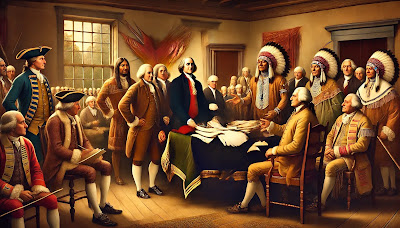#9. The Good Confederacy
The word "Confederacy" has a complicated history in America. I guess we had some kind of big civil war in the 1860s? I'm not too familiar with the details, but by all accounts it was really not "cash money". What I can tell you for sure though, was that the Confederate States of America was not the first Confederacy in America, not by a long shot.
The Iroquois Confederacy, known as the Haudenosaunee, represents one of the oldest and most enduring examples of democratic governance in North America. Established centuries before European settlers arrived, the Confederacy united five Indigenous nations—the Mohawk, Oneida, Onondaga, Cayuga, and Seneca—under a constitution known as the Great Law of Peace. This alliance later included the Tuscarora, becoming what was known as the Six Nations. The Peacemaker, a legendary figure in Haudenosaunee history, is said to have introduced the Great Law, aiming to end long-standing conflicts among these nations. This foundational law fostered unity, diplomacy, and mutual respect, allowing the Confederacy to maintain peace among its members and demonstrating that diverse groups could function collectively.
The Iroquois Confederacy was structured around a Grand Council made up of sachems, or chiefs, representing each of the six nations. Each nation retained its autonomy but sent delegates to the council to participate in collective decision-making. Rather than a majority rule, the Confederacy operated through consensus—all decisions required agreement among representatives to ensure harmony and maintain unity (Sounds exhausting, but good for them!).
Women, particularly Clan Mothers, played a crucial role in the political structure. They held the authority to nominate and depose chiefs, emphasizing the importance of balance and accountability in leadership. This system of shared power, where representatives worked cooperatively for the good of all, set a compelling example of governance based on collaboration, with checks and balances embedded in its structure to maintain peace and equity.
As colonial leaders began to explore ideas for uniting the thirteen colonies, many studied Native American governance practices, including the Iroquois Confederacy’s Great Law of Peace. Benjamin Franklin was one of the first to observe the Confederacy’s system closely. In the 1750s, he encountered Iroquois leaders at the Albany Congress, where he proposed the Albany Plan of Union—an early framework for colonial unity inspired by the Iroquois’ federal model. Franklin admired the Confederacy’s ability to maintain unity and noted, “It would be a strange thing if Six Nations of ignorant savages should be capable of forming a scheme for such a union... and yet that a like union should be impractical for ten or a dozen English colonies.” (Yikes Ben, we don't talk like that any more, how embarrassing. This is why you'll never be as cool as John Adams.)
John Adams and Thomas Jefferson also took an interest in Indigenous governance. Adams expressed respect for the independence and equality present in Native American councils, while Jefferson, a proponent of decentralized power, was fascinated by Indigenous governance’s emphasis on local autonomy. Although they did not directly cite the Iroquois Confederacy in their writings on American governance, they were influenced by the democratic principles exemplified in Indigenous political systems they observed.
The Iroquois Confederacy’s Great Law of Peace remains a testament to the power of unity, consensus, and respect among diverse groups. While the extent of its direct influence on the Founding Fathers is debated, its principles of cooperative governance and mutual accountability resonate with the ideals of American democracy. Recognized by the U.S. Congress in the 1980s for its possible role in shaping democratic thought, the Great Law of Peace continues to stand as a remarkable example of Indigenous contributions to the foundations of governance in North America.

